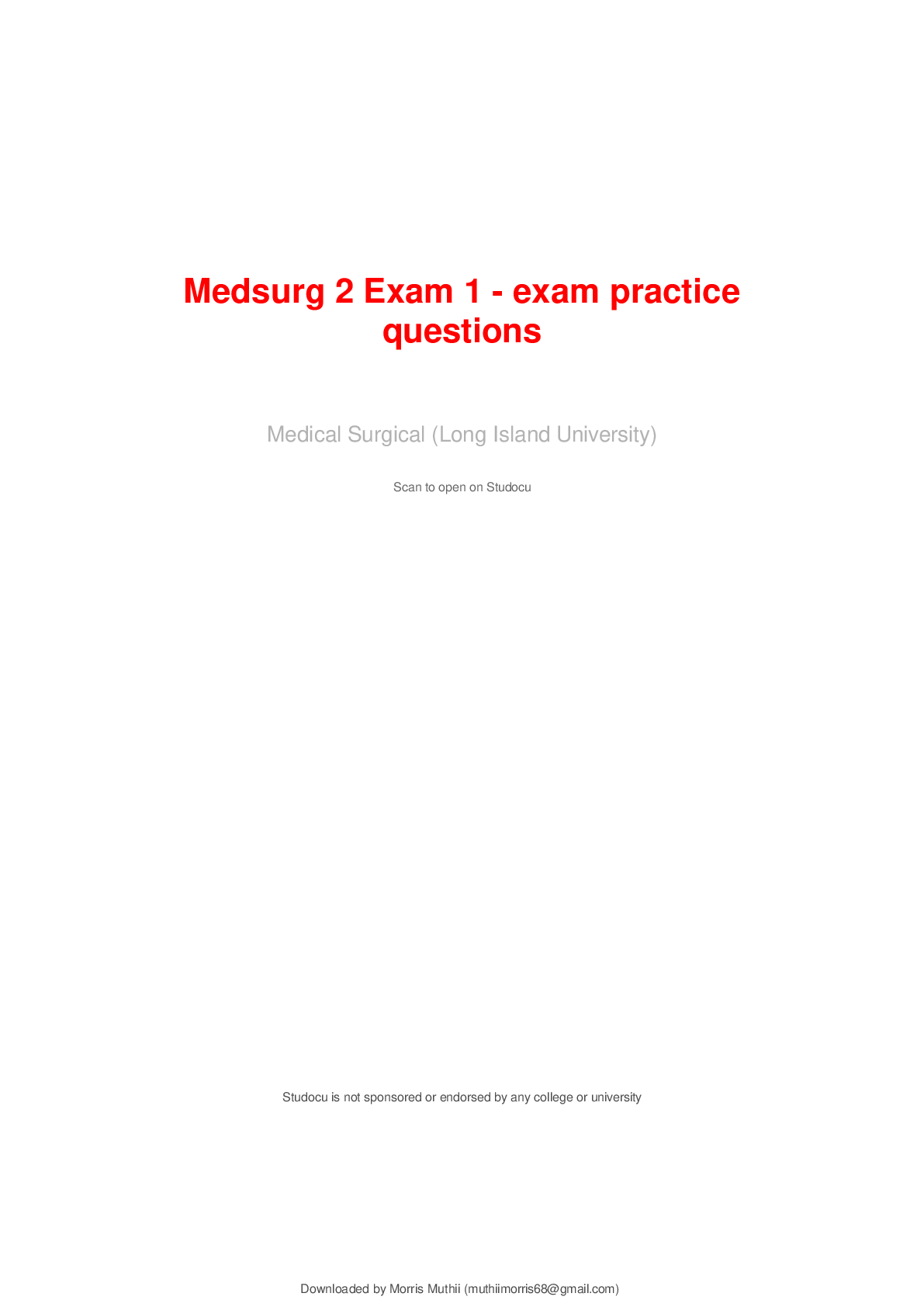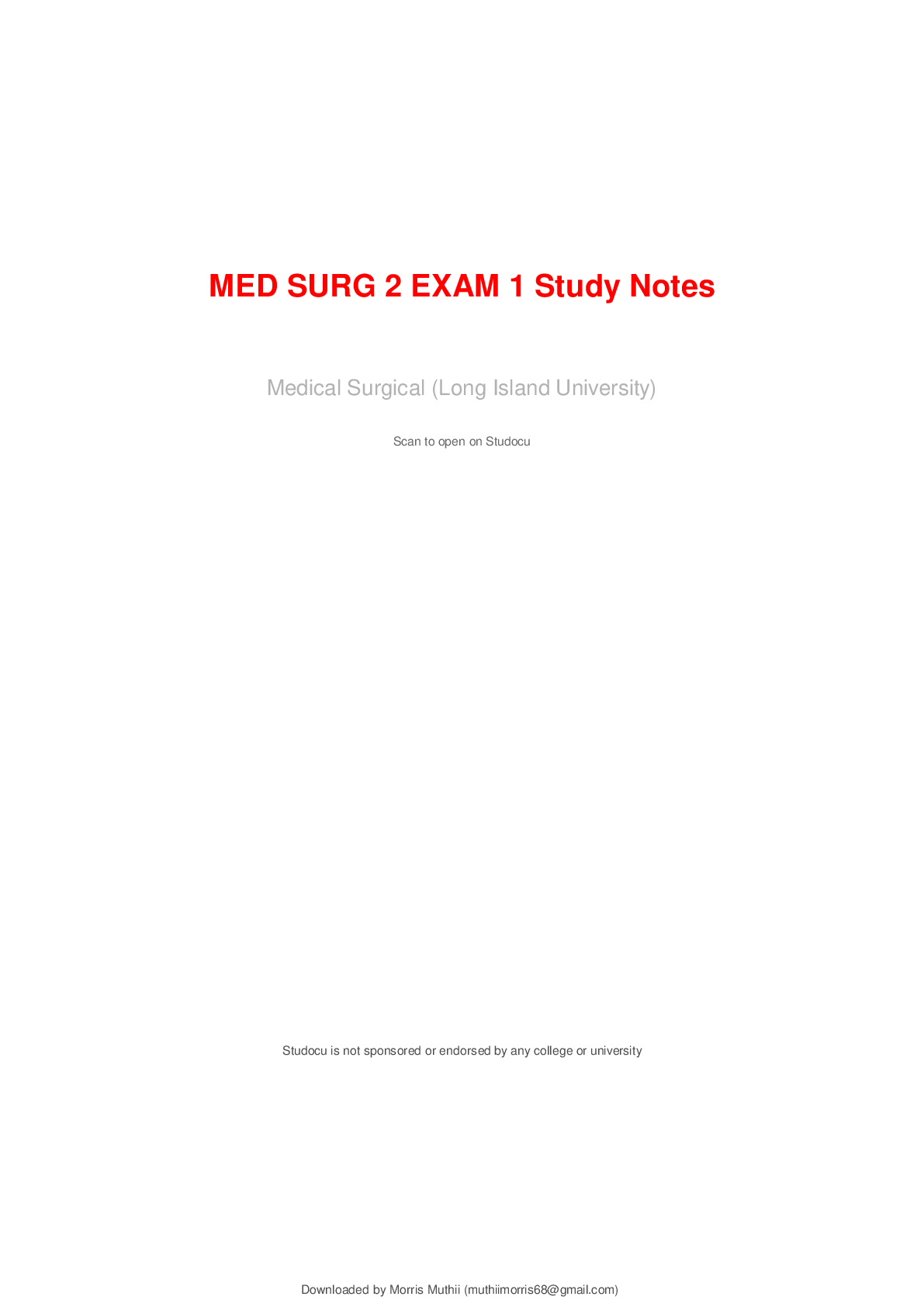Bundle > Medsurg cardiac meds, CAD, angina (part1)
Medsurg cardiac meds, CAD, angina (part1)
Systemic Transport: Process of providing enough blood, oxygen, and nutrients to the cells of the body. -Heart begins to beat at 8 weeks gestation -Our heart needs 70-80% of Oxygen and is perfused du... ring Diastole (resting period) *Our Heart Needs: Adequate Cardiac Pump, Satisfactory and Passable Vasculature, Sufficient Blood Supply* Blood Flow Recap: De-oxygenated blood enters the Right Atrium coming from the body via superior and inferior vena cava, passes the Tricuspid Valve into the Right Ventricle. . Out to Pulmonary Artery which carries the deoxygenated blood into the lungs. . Oxygenated blood comes back to the heart through the Pulmonary Veins into the Left Atrium – through Bicuspid/Mitral Valve, into the Left Ventricle and out the Ascending & Descending Aorta to supply the rest of the body. Definitions Hypoxemia: low O2 in blood / Acidosis: Occurs from low contractility of the heart Cardiac Output = Stroke Volume X Heart Rate (the volume of blood ejected from the ventricle in one minute) Normal cardiac output is usually 4-8L/Min. -reduced cardiac output can be caused by MI, heart failure due to hypertension, heart diseases, arrythmias, pulmonary disease, fluid overload, decreased fluid volume, electrolyte imbalances, or medication effects. -Signs of decreased cardiac output: tachycardia, tachypnea, decreased peripheral pulses, cool skin, angina, exercise intolerance, decreased urine output, volume overload, lung crackles, orthopnea, pedal edema, hypotension. Stroke Volume: Amount of blood ejected per heartbeat ; 60-130 is average *SV is determined by Pre-load and After-load Pre-load: the Stretch of the muscle fibers at the end of diastole -Diastole: heart is resting while the chambers fill After-load: the pressure that the ventricles must overcome in order to be able to eject blood out of the heart during systole ( Ejection: Right ventricle pumping to Pulmonary artery & the Left Ventricle pumping to Aorta) -Systole: contraction of the heart / how hard they “squeeze” -Increased Contractility = Increased Stroke Volume (SV) -Contraction = Our pulse that we record What Decreases Pre-load? Diuretics, Vasodilators, Hemorrhage What Increases Pre-load? IV Fluids, Blood transfusion, Overhydration Vasoconstriction: narrowing of blood vessels (SNS: increases HR, Increases BP) Vasodilation: opening of a blood vessel (SNS blocked: decreased HR, decreases BP) *Vasodilation and Vasoconstriction are influenced by Baroreceptors Arteriosclerosis: Hardening of endothelial lining in arteries. Occurs frequently with age. (CAD) Atherosclerosis: Build-up of plaque wall by fatty lipids. – Risk of thrombus formation, traveling, causing clot, etc. **Most discussed in this lecture. (CAD) An indicator of atherosclerosis is Claudication* which is cramping in the legs induced by exercise, or excessive walking (can be intermittent) -Can begin developing in childhood -Damage to endothelium and continues to accumulate -Plaque build-up -Decreases or occludes blood flow -Decreases oxygen supply and can cause ischemia (Angina) or Necrosis (MI) -Pain in lower extremities can occur due to hardening of arteries that decrease oxygen flow to the rest of the body Atheroma: fibrous cap forming within arteries, aka plaque. Hematopoiesis: Production of blood. Occurs in bone marrow; Renal system produces erythropoietin to help with production when needed Normal HgB Men 13-17 / Women 12-15 Normal HCT Men 41-50% / Women 36-44% Normal HgbA1c between 4-5.6% / Diabetics would be 6.5% or higher Cholesterol: Fat soluble; synthesized in the liver / Normal Cholesterol total levels <200 -High Density (HDL’s) “Happy” – Protects the heart by removing lipids from the blood and transports cholesterol to liver, beneficial for our artery’s! Norms: >40 for males , >50 for women -Low Density (LDL’s) “Lousy” – transports the cholesterol to our tissues, which has a harmful effect on our artery’s! -Increased LDL levels indicate high risk of CVD, stroke, and PAD Norms: <100 ** for high Risk patients with Cardiac Issues <70. *Lipid panels are usually done around age 20- and then frequently as routine. Fasting Values patient should be NPO 8-12 hrs. before ; Glucose makes blood thicker; hyperglycemia causes injury to blood vessels in time. Complications of CAD (Atherosclerosis): Hypertension, Angina, MI, CVA, TIA, Peripheral Arterial Disease, Kidney Disease, Risk for Metabolic Syndrome -Metabolic Syndrome: other issues occur, such as hypertension, DM, altered lipid metabolism due to increased cholesterol level0073 *Patient will be diagnosed with metabolic syndrome if >2 of these factors present Risk Factors of CAD: Modifiable and Non-Modifiable Gender, Age, family history, race, exercise, hyperlipidemia, obesity, diabetes, smoking, alcohol intake, excessive salt intake in diet, women have higher complications and are at increased risk after menopause due to lower estrogen levels (they are heart protective), stress, sedentary lifestyle Manifestations of CAD: Increased HR, RR, BP – Palpitations – SOB – Dizziness due to decrease oxygen to brain -Chest pain (1st Nursing Action is to do EKG!!) – Edema (due to heart failure, seen on lower extremity) – Diaphoresis – Changes in skin color (pale-greyish) Diagnostic Tests: EKG/ECG – done within 10minutes! First Nursing Action for Chest Pain! -EKG can assess conduction, abnormality of heart, MI, SA Node malfunction and more Stress Test- either done on treadmill while attached to leads or given medication Persantine given IV to increase HR and watch on EKG. Echocardiogram- checks chambers/valves, heart rhythm using ultrasound to see how blood moves throughout the heart. Cardiac Catherization: insertion of a catheter into vein/artery from antecubital, groin or jugular access and threaded into the heart; can be diagnostic/interventional purposes; Contrast is used* requires puncturing of an artery, risk for bleeding @ the site is the first assessment* -Assesses blood flow and pressures in the heart’s valves, chambers, and arteries -Used as an alternative to open heart surgery for valvular issues or arterial occlusions Nursing Interventions Pre-Op for Cardiac Cath: NPO 8-12 hrs before, outpatient procedure unless hospitalized, contrast allergies, teach about procedure and how they might feel palpitations/asked to C&DB because this moves the contrast out of pericardial cavity Nursing Interventions Post-Op for Cardiac Cath: observe for bleeding/hematoma, assess peripheral pulses in the affected extremity (1st hour- Q15min, then 2nd hour- Q30min, then Q4H), neurovascular assessment, screen cardiac monitor for dysrhythmias, bedrest 2-6 hrs post op, report chest pain, monitor contrast effects and increase hydration, ensure safety. *Neurovascular assessment includes: color, warmth, pulse strength, sensation, movement, pain in the extremity of access site. -if a clot occurs, the affected limb will appear red, swollen, decreased capillary refill, pain Labs: -Lipid Profiles (8-12hr fasting) -Electrolyte Checks – Na 135-145 / K+ 3.5-5 / Ca 8.5-10 / Magnesium 1.8-3.0 -C-Reactive Protein – Produced by the liver in response to Inflammatory Response -CPK- specific cardiac enzymes that may be elevated; these enzymes enter the blood stream in response to an ischemic event -CKMB (Cardiac) should be 0%. After an MI, increased for 2-3 days -First one is done STAT, then done Q8H, peaks in 24hrs -Troponin – most accurate to the heart; usually less than 0.1, after an MI would be elevated for 1- 2 weeks. -Usually a 1x draw, begins to rise in a few hours of the MI -TEE (Transesophageal Echocardiography) views backside of the heart; Ejection Fraction % we want to know. -Hemodynamic Monitoring: -Patient on ICU/CCU unit / Central line place within vessels to monitor -done for 72-96Hrs or less, based on policy of facility. This is because the increased risk of infection aka CLABS (Central Line Associated Blood Stream Infection) -Accessed via central venous access: jugular, subclavian, or femoral Nursing Interventions for CAD O2 Therapy – Assess HR&BP -Assess I&O -Daily Weights -Proper positioning -Educate -Emotional Support -Rehab support -Modifiable Risk factor teaching Teach: Orthostatic Hypotension; change position slowly, dangling, dizziness Exercise 30min/day, smoking cessation, maintain ideal weight Normal BMI 18.5-25, Heart healthy diet , control BP and cholesterol levels, DASH diet recommended, limit alcohol intake, daily sodium <2400mg, increase fiber, low fat [Show More]
Last updated: 2 months ago
Bundle contains 4 items
This Bundle Contains 4 Items
ATI Med Surge/ ATI Medsurg> EXAM > Medsurg 2 Exam 1 - exam practice questions (All)

Medsurg 2 Exam 1 - exam practice questions
Venturas Exam #1 1. A nurse is assessing a client with rheumatoid arthritis (RA). Which of the following findings should the nurse expect? a. Weight loss b. morning stiffness less than 30 minu...
By NurseBailley
EXAM
$18.5
0
ATI Med Surge/ ATI Medsurg> LECTURE SLIDES/NOTES > MED SURG 2 EXAM 1 Study Notes (All)

MED SURG 2 EXAM 1 Study Notes
MED SURG 2 EXAM 1 STUDY NOTES UNIT TOPIC TB CHAPTER Unit 9: Musculoskeletal Function Assessment of Musculoskeletal Function 39 ATI CHAPTER 67-72 Pharm: 34,45 Musculoskeletal...
By NurseBailley
LECTURE SLIDES/NOTES
$14.5
0
ATI Med Surge/ ATI Medsurg> LECTURE SLIDES/NOTES > Medsurg cardiac meds, CAD, angina (part1) Comprehensive Nursing Care I (All)

Medsurg cardiac meds, CAD, angina (part1) Comprehensive Nursing Care I
Med Surg- Cardiac (part 1) Systemic Transport: Process of providing enough blood, oxygen, and nutrients to the cells of the body. -Heart begins to beat at 8 weeks gestation -Our heart needs 70-80%...
By NurseBailley
LECTURE SLIDES/NOTES
$14.5
0
ATI Med Surg> Summary > Med surg week 9 , 10 , 11 , 12 wk 13 is exam (All)

Med surg week 9 , 10 , 11 , 12 wk 13 is exam
Functions of Kidney; -produce urine - eliminated excess waste and toxicity - Uremia (urine goes into bloodstream) -water volume or hydration status - fluid volume excess -Blood Pressure regulation - U...
By NurseBailley
Summary
$20.5
0
Reviews( 0 )
More information
Uploaded On
Mar 17, 2025
Language
English
Type
Bundle
Number of Documents:
4






